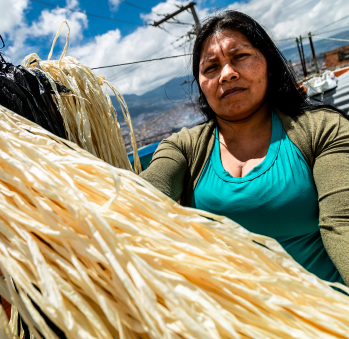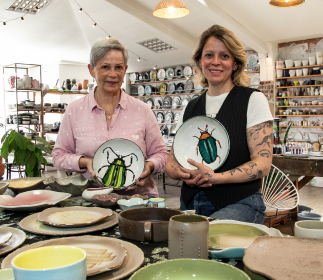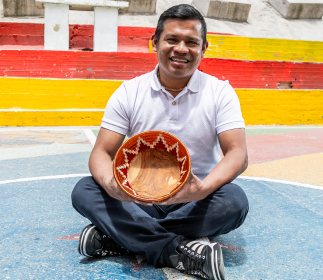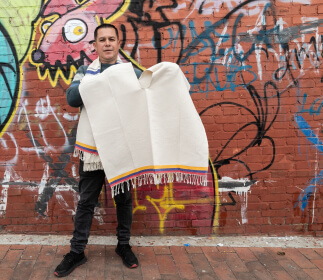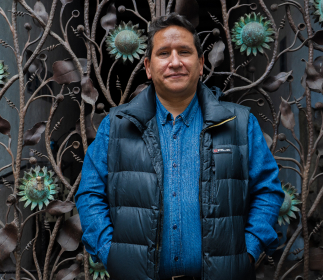Arcenio Moya
Workshop: Nawema
Craft: Weaving
Trail: Bogotá Route
Location: Bogotá, Bogotá
Arcenio Moya arrived in Bogotá not by choice, but as a means of escaping the threat of forced recruitment by armed groups that terrorized the youth in his homeland, along the San Juan River between Chocó and Valle del Cauca. It was 2006, he was 24, and he didn’t speak a word of Spanish. Reflecting on his arrival in the capital, he sighs, recalling how challenging it was to navigate the city—deciphering bus signs, adapting to the concrete jungle, the vastness, and the overwhelming presence of people, compounded by his sense of alienation. He sighs because he cried, and for almost two years he felt he might never understand anything, and he resented the hostility he faced, despite his gentle and sweet demeanor. But as is often the case when you have no choice but to be strong, he persevered.
In Ciudad Bolívar, he was welcomed by his uncle Sercelinito Pirazá, a leader of the Wounaan indigenous community, who inspired him to believe in his potential. Following his uncle’s example, Arcenio sought employment and found a job in a restaurant. He started washing dishes and worked his way up through various roles, even managing one, which sparked his dream of opening his own place. Over the years, he forged an identity that helped him understand his new world—one that was teaching him a new language, social dynamics, beliefs, friendships, and accents.
Yet he felt the calling of his land and river. His roots, family, and rituals. Unable to resist the pull, he began to explore the traditional craft of weaving werregue palm, practiced by his fellow Wounaan, including his uncle Sercelinito. He immersed himself in watching the women work with the fiber and understanding the deep meanings behind their symbols. He became a skilled weaver and took on a leadership role within his community. However, this role led to some friction with other Wounaan leaders in Bogotá, prompting him to establish a new group in Brisas del Volador, in the sprawling Ciudad Bolívar.
There, alongside 18 master weavers and under the brand Nawema, which aims to preserve their ancestral knowledge, Arcenio and his team have set out to bring an innovative touch to werregue designs. Traditionally used for making utilitarian items like vessels, Arcenio and his group have started creating large-scale pieces such as wide-mouthed containers and trays that leave viewers breathless. Moreover, they’ve managed to infuse their work with symbols that reflect their experiences in the city. What might appear to us as striking geometric triangles takes on new meaning when we learn that these are “”tears of cement,”” the sorrows woven by the elder women that become shared life experiences. They also incorporate the city’s colors—the defining brick red of Bogotá—honoring their Wounaan palette with vibrant orange.
This represents a new generation in werregue design, blending the mastery of traditional fiber weaving from the Chocó jungles with an interpretation of the city that embraced its artisans. Through their work, they reflect and beautify their new environment. Additionally, Arcenio’s father, Alejandrino Moya, is a jaibaná, a spiritual authority in their community, and for that reason, a carver of their traditional spirits boats. These balsawood pieces, imbued with symbolic meaning and intended to protect their holders, are also part of what Arcenio offers through Nawema. Listening to him talk about these pieces—owls that stay awake to ward off bad energies and night witches, hummingbirds that alert to threats, parrots that communicate dangers, and crocodiles, turtles, snakes, and armadillos that scare away malevolent spirits—one is drawn into a journey through Wounaan spirituality and beauty.
Craft




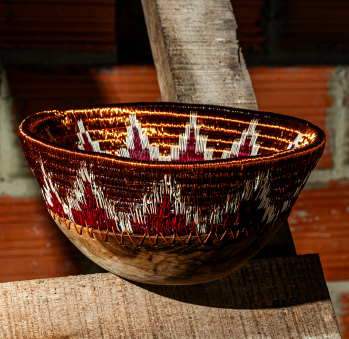













Artisans along the way
Artisans along the way
No puede copiar contenido de esta página








































